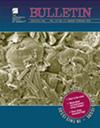美国中大陆东部前寒武纪基底跨地壳剪切带形成与再活化的大地电磁分析
IF 3.9
1区 地球科学
Q1 GEOSCIENCES, MULTIDISCIPLINARY
引用次数: 0
摘要
区域长周期大地电磁资料的三维反演揭示了美国东部中大陆前寒武纪基底存在两套不同的高导电性带。其中一组位于密苏里州、伊利诺伊州、印第安纳州和俄亥俄州西部,由西北-东南取向的电导率结构定义;另一组位于肯塔基州、西弗吉尼亚州、西弗吉尼亚州和俄亥俄州东部的地下,包括一般面向东北-西南的结构。西北向带主要分布在古元古代地壳中,其高电导率值是由于与侵入相关的富co2流体在跨地壳剪切带内沉淀石墨所致。我们的MT反演结果表明,其中一些构造陡倾穿过地壳并与莫霍断裂带相交,这支持了剪切带起源于古元古代晚期或中元古代早期的“漏”行断层或变形的解释。东北向带与格伦维里安造山作用有关,也可能与亚佩坦裂谷作用有关,尽管需要进一步的工作来证实后者的可能性。我们认为这两组电导率带的不同地理位置反映了起源和/或地壳流变学的差异,其中西北走向的电导率带主要形成于较老的、稳定的、前grenville克拉通的Laurentia,而东北走向的电导率带主要形成于较年轻的、较弱的边缘地壳。值得注意的是,这些高导电性带在空间上与影响显生宙地层的中大陆断裂和褶皱带相关。地层学证据表明,大陆中部断裂和褶皱带在显生宙造山活动期间特别活跃,其中一些至今仍在地震活动中,因此相关的高导电性带可能代表了横贯地壳的长期存在的弱点。本文章由计算机程序翻译,如有差异,请以英文原文为准。
Magnetotelluric insights into the formation and reactivation of trans-crustal shear zones in Precambrian basement of the eastern U.S. Midcontinent
Three-dimensional inversion of regional long-period magnetotelluric (MT) data reveals the presence of two distinct sets of high-conductivity belts in the Precambrian basement of the eastern U.S. Midcontinent. One set, beneath Missouri, Illinois, Indiana, and western Ohio, is defined by northwest−southeast-oriented conductivity structures; the other set, beneath Kentucky, West Virginia, western Virginia, and eastern Ohio, includes structures that are generally oriented northeast−southwest. The northwest-trending belts occur mainly in Paleoproterozoic crust, and we suggest that their high conductivity values are due to graphite precipitated within trans-crustal shear zones from intrusion-related CO2-rich fluids. Our MT inversion results indicate that some of these structures dip steeply through the crust and intersect the Moho, which supports an interpretation that the shear zones originated as “leaky” transcurrent faults or transforms during the late Paleoproterozoic or the early Mesoproterozoic. The northeast-trending belts are associated with Grenvillian orogenesis and also potentially with Iapetan rifting, although further work is needed to verify the latter possibility. We interpret the different geographic positions of these two sets of conductivity belts as reflecting differences in origin and/or crustal rheology, with the northwest-trending belts largely confined to older, stable, pre-Grenville cratonic Laurentia, and the northeast-trending belts largely having formed in younger, weaker marginal crust. Notably, these high-conductivity zones spatially correlate with Midcontinent fault-and-fold zones that affect Phanerozoic strata. Stratigraphic evidence indicates that Midcontinent fault-and-fold zones were particularly active during Phanerozoic orogenic events, and some remain seismically active today, so the associated high-conductivity belts likely represent long-lived weaknesses that transect the crust.
求助全文
通过发布文献求助,成功后即可免费获取论文全文。
去求助
来源期刊

Geological Society of America Bulletin
地学-地球科学综合
CiteScore
9.30
自引率
8.20%
发文量
159
审稿时长
4-8 weeks
期刊介绍:
The GSA Bulletin is the Society''s premier scholarly journal, published continuously since 1890. Its first editor was William John (WJ) McGee, who was responsible for establishing much of its original style and format. Fully refereed, each bimonthly issue includes 16-20 papers focusing on the most definitive, timely, and classic-style research in all earth-science disciplines. The Bulletin welcomes most contributions that are data-rich, mature studies of broad interest (i.e., of interest to more than one sub-discipline of earth science) and of lasting, archival quality. These include (but are not limited to) studies related to tectonics, structural geology, geochemistry, geophysics, hydrogeology, marine geology, paleoclimatology, planetary geology, quaternary geology/geomorphology, sedimentary geology, stratigraphy, and volcanology. The journal is committed to further developing both the scope of its content and its international profile so that it publishes the most current earth science research that will be of wide interest to geoscientists.
 求助内容:
求助内容: 应助结果提醒方式:
应助结果提醒方式:


